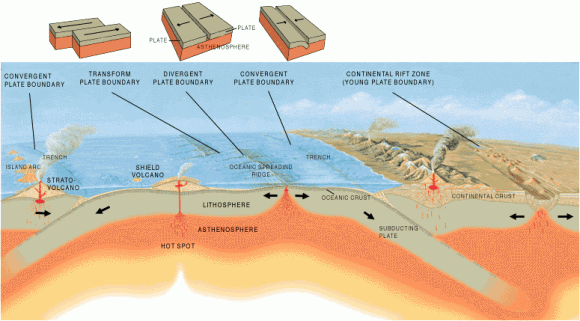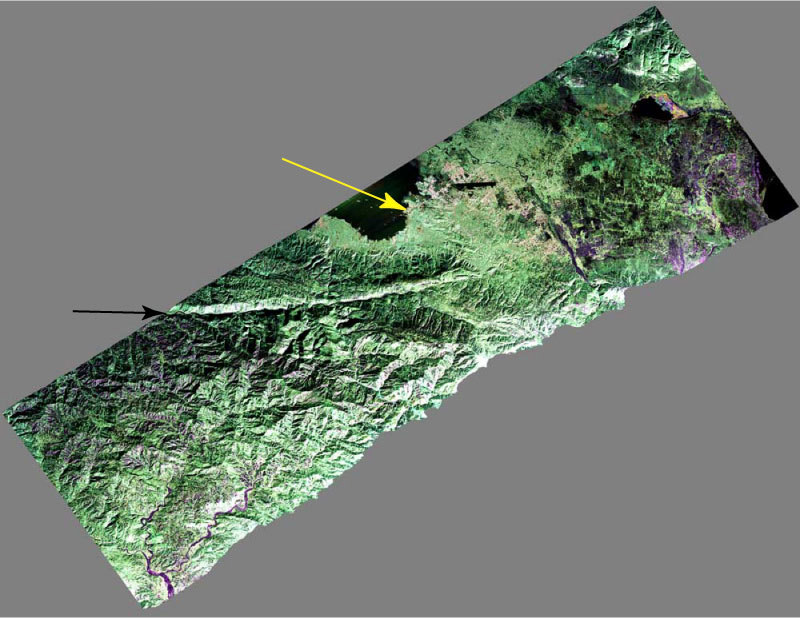Every so often, in different regions of the world, the Earth feels the need to release energy in the form of seismic waves. These waves cause a great deal of hazards as the energy is transferred through the tectonic plates and into the Earth’s crust. For those living in an area directly above where two tectonic plates meet, the experience can be quite harrowing!
This area is known as a fault, or a fracture or discontinuity in a volume of rock, across which there is significant displacement. Along the line where the Earth and the fault plane meet, is what is known as a fault line. Understanding where they lie is crucial to our understanding of Earth’s geology, not to mention earthquake preparedness programs.
Definition:
In geology, a fault is a fracture or discontinuity in the planet’s surface, along which movement and displacement takes place. On Earth, they are the result of activity with plate tectonics, the largest of which takes place at the plate boundaries. Energy released by the rapid movement on active faults is what causes most earthquakes in the world today.

Since faults do not usually consist of a single, clean fracture, geologists use the term “fault zone” when referring to the area where complex deformation is associated with the fault plane. The two sides of a non-vertical fault are known as the “hanging wall” and “footwall”.
By definition, the hanging wall occurs above the fault and the footwall occurs below the fault. This terminology comes from mining. Basically, when working a tabular ore body, the miner stood with the footwall under his feet and with the hanging wall hanging above him. This terminology has endured for geological engineers and surveyors.
Mechanisms:
The composition of Earth’s tectonic plates means that they cannot glide past each other easily along fault lines, and instead produce incredible amounts of friction. On occasion, the movement stops, causing stress to build up in rocks until it reaches a threshold. At this point, the accumulated stress is released along the fault line in the form of an earthquake.
When it comes to fault lines and the role they have in earthquakes, three important factors come into play. These are known as the “slip”, “heave” and “throw”. Slip refers to the relative movement of geological features present on either side of the fault plane; in other words, the relative motion of the rock on each side of the fault with respect to the other side.

Heave refers to the measurement of the horizontal/vertical separation, while throw is used to measure the horizontal separation. Slip is the most important characteristic, in that it helps geologists to classify faults.
Types of Faults:
There are three categories or fault types. The first is what is known as a “dip-slip fault”, where the relative movement (or slip) is almost vertical. A perfect example of this is the San Andreas fault, which was responsible for the massive 1906 San Francisco Earthquake.
Second, there are “strike-slip faults”, in which case the slip is approximately horizontal. These are generally found in mid-ocean ridges, such as the Mid-Atlantic Ridge – a 16,000 km long submerged mountain chain occupying the center of the Atlantic Ocean.
Lastly, there are oblique-slip faults which are a combination of the previous two, where both vertical and horizontal slips occur. Nearly all faults will have some component of both dip-slip and strike-slip, so defining a fault as oblique requires both dip and strike components to be measurable and significant.

Impacts of Fault Lines:
For people living in active fault zones, earthquakes are a regular hazard and can play havoc with infrastructure, and can lead to injuries and death. As such, structural engineers must ensure that safeguards are taken when building along fault zones, and factor in the level of fault activity in the region.
This is especially true when building crucial infrastructure, such as pipelines, power plants, damns, hospitals and schools. In coastal regions, engineers must also address whether tectonic activity can lead to tsunami hazards.
For example, in California, new construction is prohibited on or near faults that have been active since the Holocene epoch (the last 11,700 years) or even the Pleistocene epoch (in the past 2.6 million years). Similar safeguards play a role in new construction projects in locations along the Pacific Rim of fire, where many urban centers exist (particularly in Japan).
Various techniques are used to gauge when the last time fault activity took place, such as studying soil and mineral samples, organic and radiocarbon dating.
We have written many articles about the earthquake for Universe Today. Here’s What Causes Earthquakes?, What is an Earthquake?, Plate Boundaries, Famous Earthquakes, and What is the Pacific Ring of Fire?
If you’d like more info on earthquakes, check out the U.S. Geological Survey Website. And here’s a link to NASA’s Earth Observatory.
We’ve also recorded related episodes of Astronomy Cast about Plate Tectonics. Listen here, Episode 142: Plate Tectonics.
Sources:

